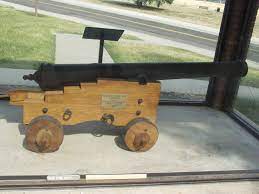Today we are checking out the Falcon cannon. An artillery piece that played a pivotal role on the battlefield. You will learn what made this artillery piece so powerful, and what were its advantages and disadvantages. And of course, what led to it being displaced from the battlefield altogether?
So, now let’s start things off with a short description of what a Falcon cannon is.
What Is The Falcon Cannon?
Falcon cannons were powerful medieval artillery pieces known for their exceptional firepower and range. They played a crucial role in battles and sieges during the late 15th and early 16th centuries. They fired iron cannonballs of varying calibers and were renowned for their effectiveness in breaching fortifications.
Now that we’ve covered the introduction to Falcon cannons, let’s explore their physical characteristics and materials in detail.
Physical Characteristics Of The Falcon Cannon

These cannons measured around 12 feet in length and weighed several tons. The main body of the cannon was predominantly constructed using cast iron or bronze, known for its durability and resistance to the intense pressures generated during firing.
The barrel featured a smooth bore, allowing for the effective launching of various projectiles. The design of the Falcon cannon ensured stability and ease of transportation, making it a versatile asset on the battlefield.
Caliber And Projectiles Of Falcon Cannons
When it came to firepower, Falcon cannons were equipped with a range of projectiles suited for different purposes.
The cannonballs fired from Falcon artillery ranged from 2 to 6 inches in diameter. The Falcon cannon’s caliber determined the weight and size of the projectiles it could accommodate, influencing its destructive potential and range.
In addition to regular cannonballs, Falcon cannons were capable of launching other specialized ammunition. Among them being grapeshot for anti-personnel attacks and explosive shells for breaching fortifications.
Impact Of The Falcon Cannon
Falcon cannons found extensive use in various historical settings. They played a crucial role in famous battles such as the Siege of Constantinople in 1453.
In these engagements, Falcon cannons proved instrumental in breaching fortifications and causing significant casualties among enemy forces. These cannons’ range and destructive power often dictated the tactical decisions made by commanders on the battlefield. Their effectiveness in siege warfare made Falcon guns vital assets for both attackers and defenders.
But given that the Falcon cannon disappeared from the battlefield they surely had some flaws, right? Well, yeah they did.
Disadvantages Of Falcon Cannons
Falcon cannons did have certain disadvantages that contributed to their eventual decline.
One notable drawback was their slow reloading process, requiring skilled gunners and a substantial crew to operate efficiently. On top of that, Falcon cannons were susceptible to damage from the intense heat and pressures generated during firing, necessitating regular maintenance and repairs. As warfare evolved and more advanced artillery technologies emerged, Falcon cannons gradually became less prominent on the battlefield.
The reason for that was very simple. Better guns came around. Let’s take a look at what guns came after the Falcon.
Successors To Falcon Cannons
A notable successor to the Falcon cannon was the Culverin. Culverins incorporated improvements in design, featuring longer barrels and more efficient mechanisms for loading and firing. These advancements allowed for enhanced accuracy and a higher rate of fire compared to their predecessors. Culverins became widely utilized in warfare, marking a significant evolution in artillery technology.
If you want to take a look at what made the Culverin cannon so effective, then click here to visit an article on just that topic.
In Conclusion
Thank you for taking the time to read this article. I hope you learned a thing or two. And I will see you at the next one. I suggest taking a look at one of the more modern cannons “the Armstrong gun“.
Take care!
Sources:
“Artillery: An Illustrated History of its Impact” by Jeff Kinard